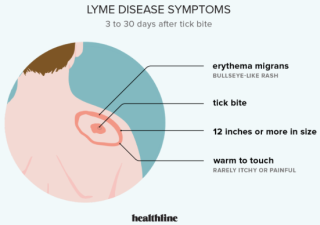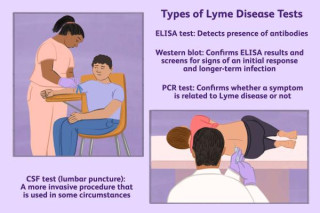What is Lyme Disease?created at May 06, 2009 1,354 1,354 Lyme disease is a bacterial infection transmitted to humans through the bite of infected blacklegged ticks.The bacteria responsible is Borrelia Burgdorferi (and in some areas, |
Does Lyme disease affect mental functioning?updated at Nov 07, 2025 1,332 1,332 Does Lyme Disease Affect Mental Functioning?Lyme disease, |
How do I know if I have got Lyme disease?created at May 06, 2009 1,189 1,189 Lyme disease symptoms can vary greatly but often begin with a characteristic expanding rash (erythema migrans) at the site of a tick bite.Other early symptoms may include fever, |
Can Lyme Disease be prevented?updated at Nov 08, 2025 1,277 1,277 Lyme disease prevention primarily focuses on avoiding tick bites.This can be achieved through wearing long sleeves and pants when in tick-infested areas, |
Will my doctor treat me for Lyme disease?updated at Sep 06, 2025 1,246 1,246 Doctors typically treat Lyme disease when a patient presents with symptoms consistent with the disease, |
Does other diseases accompany Lyme Disease?updated at Nov 08, 2025 1,673 1,673 Lyme disease can often be accompanied by other diseases or conditions. These are sometimes referred to as co-infections or opportunistic infections.Here's a breakdown:Co-infections: These are other tick-borne diseases that can be transmitted at the same ti... |
A test for Lyme Diseaseupdated at Nov 08, 2025 1,300 1,300 Two-Tiered Serological TestingThe most common approach to testing for Lyme disease involves a two-tiered serological process using blood tests.This method looks for antibodies your body produces in response to Borrelia burgdorferi, |
Is Lyme disease a New Illness?updated at Nov 07, 2025 1,754 1,754 Is Lyme Disease a New Illness?Lyme disease is not a new illness.Although formally identified and named in 1975 following an outbreak in Lyme, |
What is the treatment for Lyme disease?updated at Oct 31, 2025 1,176 1,176 Key Points about Lyme Disease Treatment?:Antibiotics are the Primary Treatment: The standard treatment for Lyme disease is with antibiotics.Early Treatment is Crucial: Antibiotics are most effective when started as early as possible after infection.Prompt ... |
How prevalent is Lyme disease?updated at Nov 07, 2025 1,480 1,480 Lyme Disease Prevalence: A Public Health ConcernLyme disease stands as the most common vector-borne illness in both the United States and Europe.Its widespread presence and the challenges associated with diagnosis and reporting make it a significant public... |
What are the commonest Lyme Disease Symptoms at onset?updated at Nov 08, 2025 1,435 1,435 Lyme disease, |
How does Lyme Disease start?updated at Nov 08, 2025 1,347 1,347 Lyme disease is an infectious disease caused by a spiral-shaped bacterium of the *Borrelia* genus, |
Unraveling Borreliosis: Understanding the Disease Caused by Borrelia Bacteriaupdated at Nov 08, 2025 1,300 1,300 Borrelia BacteriaBorreliosis, |
How does Lyme disease infection occur?updated at Oct 30, 2025 1,284 1,284 Lyme disease infection occurs through the bite of an infected blacklegged tick (also known as a deer tick).These ticks acquire the bacteria, |
How to remove Attached Ticks ?updated at Nov 08, 2025 1,405 1,405 Prompt tick removal is crucial, |
Lyme disease in Domestic Animalsupdated at Nov 08, 2025 1,283 1,283 Lyme Disease in Domestic AnimalsLyme disease, |
Treatment for Lyme diseasecreated at May 06, 2009 1,270 1,270 Lyme disease is treated with antibiotics, |
Recognizing Lyme Disease Symptoms in Humans: A Comprehensive Guidecreated at May 06, 2009 1,479 1,479 Lyme disease, |
Unveiling the Role of the Deer Tick in Lyme Disease Casescreated at May 06, 2009 1,384 1,384 The deer tick, |
Decoding Lyme Disease Diagnosis: Unraveling the Mysteryupdated at Nov 08, 2025 1,417 1,417 The Diagnostic Dilemma of Lyme DiseaseDiagnosing Lyme disease is notoriously complex and frustrating, |











